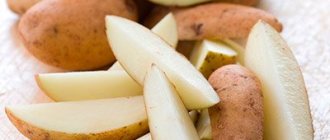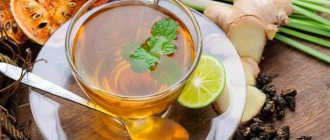For many, the word “diet” is associated with severe restrictions and hunger strike. Of course, some “weight loss” diets do justify this opinion, but not the Mediterranean one. This is a food system based on the cuisine of Mediterranean countries (UNESCO even recognized it as their national heritage). The diet is useful both for the figure and for the general strengthening of the body. It is believed that if you regularly eat according to these rules, you can extend your youth by 7 years. And besides, the Mediterranean diet for weight loss has no medical contraindications.
The essence of the Mediterranean diet
The essence of the Mediterranean diet is simple: it is necessary to remove from the menu, or reduce to a minimum the consumption of red meat, refined carbohydrates and industrially processed foods. The emphasis is on complete proteins, healthy fats, grains and fruits. This will help maintain normal weight, as well as keep the heart and blood vessels healthy.
Mediterranean food traditions are:
- Plant food sources.
- There is an abundance of whole grain cereals on the menu.
- Eating foods that are in season.
- Eating products that have undergone minimal processing before serving.
- Olive oil as the main source of fat.
- Abundance of dairy products.
- Fat intake per day is from 25 to 35%.
- Mandatory consumption of fish and poultry as the main source of meat.
- Red meat on the table - 2 times a month.
- No more than 4 eggs per week.
- Drinking wine (1-2 glasses).
In a month of the Mediterranean diet you can get rid of 3-5 kg of excess weight. Losing such volumes will not harm your health, which is very important when following any diet.
Is it possible to lose weight on this diet?
Research shows that people who follow a Mediterranean diet and exercise do not have problems with excess weight. And all because this system is based on the principles of proper and healthy nutrition.
The basic rules of the Mediterranean diet are to eat small meals and meals. The main emphasis is on fiber-rich plant foods and proteins, which are useful for both burning fat and gaining muscle mass. Most Mediterranean recipes are a healthy combination of meat and plant foods, and contain a minimum of harmful additives and sugar. Another advantage of this nutrition system is drinking plenty of fluids. While following the diet, you need to drink at least 6 glasses of pure still water every day. And water, as you know, is the best assistant for losing weight and cleansing the body of toxins.
Based on the Mediterranean nutrition system, nutritionists have developed more strict diets for weight loss. For example, there is the “Three Soups” diet, the essence of which is to consume one of the traditional Mediterranean dietary soups for lunch and dinner: gazpacho, minestrone or pesto for a certain period of time (from a week to 21 days). In addition to soups, during the period of weight loss you can include fish, low-fat cottage cheese, poultry and a lot of vegetables in your menu. And I must say that the reviews about this diet are only positive.
Mediterranean diet rules
The diet requires compliance with the following rules:
- Dressing for all salads without exception is olive oil.
- You can only drink red wine (semi-dry or dry).
- If the product can be eaten raw, then it is not subjected to heat treatment.
- Possible cooking options: steaming, boiling, baking, stewing. Frying foods is not recommended.
- To boil cereals for a short period of time, they are pre-soaked.
- Banned: fast food, sweets, processed foods.
- The last meal is 4 hours before the night's rest.
- Salt is used in minimal quantities. You can add oregano, garlic, basil, and thyme to dishes.
- Sugar should be replaced with stevia or honey.
Zucchini with feta cheese
Vegetables cooked in the oven are a great option for a dish that is healthy and takes up little time in the kitchen.
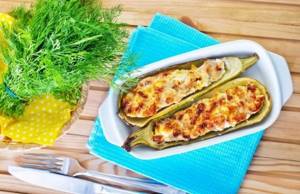
One option is Zucchini with feta cheese.
Composition of ingredients
Compound:
- zucchini (small) – 4 pcs.;
- feta cheese – 200 g;
- garlic – 1 clove;
- olive oil – 1 tbsp;
- mint;
- spices;
- pine nuts.
Step-by-step cooking process
Zucchini with cheese is prepared in 4 steps:
- To prepare the zucchini for baking, you need to wash them; Peel old fruits from skin, leave young ones with skin; cut lengthwise into two parts and remove the pulp.
- Next, fry the chopped pulp in olive oil with garlic, passed through a garlic press.
- Add the remaining ingredients to this mixture: chopped feta cheese and mint, nuts and spices. Mix everything carefully.
- Fill the zucchini “boats” with the prepared filling and place in the oven at 220°C for 30 minutes.
What can I add?
You can also cook zucchini and eggplant, and use semi-hard cheese instead of feta cheese.
How to serve a dish
The dish goes well either on its own or with a side dish of boiled brown rice. Or you can use it yourself as stewed vegetables for chicken breast or turkey. Zucchini will look beautiful with parsley.
How to create the right menu?
To properly plan your daily diet, you must adhere to the following recommendations:
- Leafy vegetables – 100 g, other vegetables – 50 g.
- Potatoes – 100 g.
- Legumes – 100 g.
- Nuts – 30 g.
- Fruits: one banana, one orange and one apple. You can choose from 30 g of grapes or 200 g of watermelon/melon.
- 60 g of fish or low-fat meat per day.
- Up to 60 g of cereals (rice or pasta), 30 g of cheese.
- A glass of milk or yogurt per day, 30 g of cheese.
- One egg.
- 125 ml dry red wine.
Fish baked with cheese
Fish is a frequently consumed food in the Mediterranean diet. During the period of weight loss, it should be eaten boiled or stewed.

By changing the type of fish, you can change the calorie content and taste of the dish, while maintaining its health benefits.
Composition of ingredients
Compound:
- fish fillet – 200 g;
- low-fat kefir – 50 ml;
- semi-hard cheese – 70 g;
- olive oil – 1 tbsp. l.;
- lemon juice – 1 tbsp. l.;
- dill.
Step-by-step cooking process
Fish with cheese is prepared in 4 steps:
- The baking tray must be greased with oil and fish pieces placed on it.
- The dressing is prepared like this: you need to combine kefir, juice, herbs and mix everything. The mixture should be carefully poured onto the fish portions.
- Grated cheese should be sprinkled on top of each piece.
- Products should be kept in an oven preheated to 180°C for 15 minutes.
What can I add?
You can add chopped bell pepper to the mixture or place a tomato slice on top of the fish.
How to serve a dish
The fish can be decorated with herbs and thin lemon leaves.
Mediterranean diet menu
| Breakfast | Dinner | Snack | Dinner main | Dinner is additional | |
| 1 | Cereals with 200 g of yoghurt, bread and hard cheese, a glass of tea | Baked pike – 200 g, baked vegetables, a glass of wine or a glass of compote | Fruit salad | Boiled seafood (200 g), salad with herbs and tomatoes with olive oil dressing | A glass of kefir |
| 2 | Omelet with seafood from 2 eggs, a glass of tea | Baked trout – 100 g, pasta – 100 g, mozzarella – 2 slices | Fruits – 200 g | Rice stewed with herbs, baked squid, glass of wine or tea | Glass of yogurt |
| 3 | Curd casserole, grape juice | 200 g chicken soup with spinach, corn porridge - 100 g, baked vegetables, coffee | Nuts – 30 g, orange | Buckwheat porridge with tomatoes – 200 g, baked minced fish cutlets (pike), boiled egg, juice | Fruit salad, yogurt |
| 4 | Oatmeal with yoghurt – 200 g, toast with tomatoes and cheese, water | Pasta and shrimp – 200 g, salad with seaweed – 100 g, toast with tomatoes and cheese, a glass of wine or tea | Kiwi and apple 1 pc. | Steamed sea fish – 200 g, tomatoes and mozzarella, a glass of green tea | Toast with shrimp and cheese |
| 5 | Seafood salad – 200 g, tea | Duck breast in red wine – 200 g, zucchini stewed with thyme, a glass of tea | Fresh berries (currants or cherries), or a portion of dried fruits | Pilaf with vegetables – 200 g, grilled fish – 150 g, green tea | A glass of kefir |
| 6 | Vegetable omelet based on 2 eggs, tomatoes, orange, juice | Buckwheat porridge and turkey – 200 g, salad (apple and celery), juice | Seafood | Carp stewed in sour cream – 150 g, grilled vegetables, baked trout – 150 g | Low-fat cottage cheese with sour cream – 200 g |
| 7 | Toast with cheese and tomatoes – 2 pieces, orange, juice | Vegetable stew – 200 g, baked turkey – 100 g, fruit drink | Grapefruit | Pasta with shrimp – 100 g, baked trout with herbs – 150 g | Cottage cheese with sour cream – 200 g |
Summer salad (with chicken)
A hearty and easily digestible salad has an unusual, spicy-fruity taste, thanks to the combination of its ingredients.
Composition of ingredients
Compound:
- boiled chicken breast – 150 g;
- fresh peaches – 2-3 pcs.;
- canned pineapples – 50 g;
- celery stalks – 2-3 pcs.;
- any lettuce leaves – 150 g.

For dressing you need low-fat natural yogurt without additives (1/2 cup), mint, cinnamon, lemon zest.
Step-by-step cooking process
Summer salad is prepared in 3 stages:
- The process should begin by preparing the base of the salad: you need to cut chicken breast, peaches, pineapples and celery into small cubes. It is better to tear the lettuce leaves with your hands.
- To prepare the dressing, place yogurt in a separate bowl, add cinnamon, lemon zest, and chopped mint leaves.
- Next, you need to add the dressing to the salad base and mix gently.
What can I add?
The salad will remain tasty, healthy and consistent with the rules of the Mediterranean diet if:
- use turkey meat instead of chicken;
- peaches can be replaced with nectarines, and pineapples with orange pulp.
This type of salad will remain a healthy, low-calorie and satisfying dish.
How to serve a dish
Summer salad is not difficult to prepare in any season by purchasing some imported peaches or oranges. It is good for dinner with a glass of dry red wine. The dish can be decorated with lettuce leaves and pieces of fruit left aside.
Permitted and prohibited products
The Mediterranean diet is represented by a pyramid. Its base is complex carbohydrates. They account for up to 60% of the menu. The next block is proteins (up to 30%), and the top of the pyramid is fats and simple carbohydrates (no more than 10%).
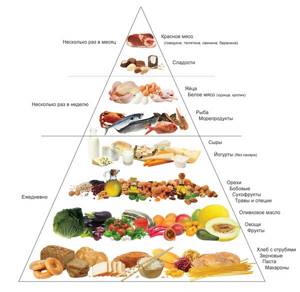
Carbohydrate foods that form the basis of the diet:
- Coated cereals (rice, barley, bulgur, etc.);
- Pasta from durum wheat;
- Wholemeal bread;
- Legumes;
- Vegetables and fruits (you need to eat at least 6 servings per day),
The center of the pyramid is products such as:
- Dairy products (up to 2 servings per day): kefir, cottage cheese, low-fat cheese, milk;
- Nuts as sources of healthy fats (one serving per day);
- Dried fruits as sources of pectin (up to 2 servings per day);
- Sea fish (no more than 6 servings per 7 days);
- Poultry (no more than 4 servings per day);
- Potatoes (no more than 3 times every 7 days);
- Egg (no more than 4 pieces per week);
- Dark chocolate and confectionery (no more than 3 times every 7 days).
Red meat is at the top of the pyramid, so lamb, beef and pork can be eaten no more than 4 times a month. In this case, the volume of servings should not exceed 100 g.
Authorized products:
| Products | Squirrels | Fats | Carbohydrates | Calorie content per 100 g |
| Greens and vegetables: | ||||
| Broccoli | 3 | 0,4 | 5,2 | 28 |
| Cilantro | 2,1 | 0,5 | 1,9 | 23 |
| Corn | 3,3 | 2,8 | 15,6 | 101 |
| Green/red/onion | 1,3/1,4/1,4 | 0/0/0 | 4,6/9,1/10,4 | 19/42/41 |
| Olives | 2,2 | 10,5 | 5,1 | 166 |
| Carrot | 1,3 | 0,1 | 6,9 | 32 |
| Chickpeas | 19 | 6 | 61 | 364 |
| cucumbers | 0,8 | 0,1 | 2,8 | 15 |
| Salad pepper | 1,3 | 0 | 5,3 | 27 |
| Parsley | 3,7 | 0,4 | 7,6 | 47 |
| Radish | 1,2 | 0,1 | 3,4 | 19 |
| White radish | 1,4 | 0 | 4,1 | 21 |
| Salad | 1,2 | 0,3 | 1,3 | 12 |
| Beet | 1,5 | 0,1 | 8,8 | 40 |
| Celery | 0,9 | 0,1 | 2,1 | 12 |
| Asparagus | 1,9 | 0,1 | 3,1 | 20 |
| Tomatoes | 0,6 | 0,2 | 4,2 | 20 |
| Pumpkin | 1,3 | 0,3 | 7,7 | 28 |
| Beans | 7,8 | 0,5 | 21,5 | 123 |
| Garlic | 6,5 | 0,5 | 29,9 | 143 |
| Lentils | 24 | 1,5 | 42,7 | 284 |
| Fruits: | ||||
| Avocado | 2 | 20 | 7,4 | 208 |
| Orange | 0,9 | 0,2 | 8,1 | 36 |
| Watermelon | 0,6 | 0,1 | 5,8 | 25 |
| Banana | 1,5 | 0,2 | 21,8 | 95 |
| Cherry | 0,8 | 0,5 | 11,3 | 52 |
| Grapefruit | 0,7 | 0,2 | 6,5 | 29 |
| Melon | 0,6 | 0,3 | 7,4 | 33 |
| Figs | 0,7 | 0,2 | 13,7 | 49 |
| Kiwi | 1 | 0,6 | 10,3 | 48 |
| Lime | 0,9 | 0,1 | 3 | 16 |
| Lemon | 0,9 | 0,1 | 3 | 16 |
| Mango | 0,5 | 0,3 | 11,5 | 67 |
| Nectarine | 0,9 | 0,2 | 11,8 | 48 |
| Apple | 0,4 | 0,4 | 9,8 | 47 |
| Berries, mushrooms: | ||||
| Grape | 0,6 | 0,2 | 16,8 | 65 |
| Sea buckthorn | 1,2 | 5,4 | 5,7 | 82 |
| Currant | 1 | 0,4 | 7,5 | 43 |
| Champignon | 4,3 | 1 | 1 | 27 |
| Nuts and dried fruits: | ||||
| Peanut | 26,3 | 45,2 | 9,9 | 551 |
| Walnut | 15,2 | 65,2 | 7 | 654 |
| Raisin | 2,9 | 0,6 | 66 | 264 |
| Cashew | 25,7 | 54,1 | 13,2 | 643 |
| Almond | 18,6 | 57,7 | 16,2 | 645 |
| Flax-seed | 18,3 | 42,2 | 28,9 | 534 |
| Dates | 2,5 | 0,5 | 69,2 | 274 |
| Pistachios | 20 | 50 | 7 | 556 |
| Cereals, pasta, porridge, bread: | ||||
| Buckwheat | 4,5 | 2,3 | 25 | 132 |
| Oatmeal porridge | 3,2 | 4,1 | 14,2 | 102 |
| Bulgur | 12,3 | 1,3 | 57,6 | 342 |
| Barley porridge | 3,1 | 0,1,84 | 22,2 | 109 |
| Brown rice | 7,4 | 2 | 72,9 | 337 |
| Barley porridge | 3,6 | 7 | 19,8 | 11 |
| Amaranth | 13,6 | 1,3 | 69 | 371 |
| Pasta 1st grade | 10,7 | 1,3 | 68,4 | 335 |
| Bran bread | 7,5 | 45,2 | 227 | |
| Chocolate: | ||||
| bitter chocolate | 6,2 | 35,4 | 48,2 | 539 |
| Seasonings, spices: | ||||
| Basil | 2,5 | 0,6 | 4,3 | 27 |
| Mustard | 5,7 | 6,4 | 22 | 162 |
| Zira | 12 | 5 | 32 | 112 |
| Ginger | 18,8 | 0,8 | 15,8 | 80 |
| Curry | 12,7 | 13,8 | 25 | 352 |
| Coriander | 1,5 | 0 | 5 | 25 |
| Cinnamon | 3,9 | 3,2 | 79,8 | 261 |
| Bay leaf | 7,6 | 8,4 | 48,7 | 313 |
| Homemade mayonnaise | 5,3 | 58,7 | 4,5 | 568 |
| Honey | 0,8 | 0 | 81,5 | 329 |
| Rosemary | 3,3 | 5,9 | 20,7 | 131 |
| Salt | 0 | 0 | 0 | 0 |
| Sage | 3,7 | 0,4 | 8 | 49 |
| Saffron | 11,4 | 5,9 | 65,4 | 310 |
| Dairy products, cheeses: | ||||
| Kefir | 3,4 | 2 | 2 | 51 |
| Yogurt 2% fat | 4,3 | 2 | 0 | 60 |
| Gouda | 25 | 27 | 0 | 356 |
| Dor blue | 21 | 30 | 0 | 354 |
| Parmesan | 33 | 28 | 0 | 392 |
| Feta | 17 | 24 | 0 | 290 |
| Cheddar | 23 | 32 | 0 | 392 |
| Oil: | ||||
| Olive oil | 0 | 99,8 | 0 | 898 |
| Alcohol: | ||||
| Dry red wine | 0,2 | 0 | 0,3 | 68 |
Foods to avoid while on the Mediterranean diet:
- Any bread that contains sugar, yeast, baking powder or dyes;
- Any preserved products;
- Any products that have a long shelf life;
- Store-bought ketchup, mayonnaise, cheese sauce and other food additives that contain sugar and preservatives;
- Sweet and semi-sweet wines, strong alcoholic drinks, dessert wines (you can drink only high-quality wine, which reduces cholesterol levels in the blood, acts as an antioxidant, accelerates metabolic processes, improves blood composition);
- Store-bought sweets: milk chocolate, candies (only dark chocolate is allowed).
Oat muffins with almonds
Sometimes you can treat yourself to homemade desserts.

In this case, the composition of the ingredients will certainly be known and there will be confidence in the absence of preservatives and harmful additives.
Composition of ingredients
Compound:
- oatmeal – 4 tbsp. l.;
- chicken egg – 2 pcs.;
- powdered milk – 4 tbsp. l.;
- baking powder – 20 g;
- almonds – 10 g.
Step-by-step cooking process
Oatmeal muffins are prepared in 4 steps:
- To prepare the dough, you need to mix the “dry” ingredients: cereal, milk, baking powder, chopped nuts.
- The eggs must be beaten and carefully combined with the “dry” mixture.
- The resulting dough should be placed in silicone molds, which do not need to be greased with oil.
- The muffins should be placed in an oven preheated to 200°C and baked for 15 minutes.
What can I add?
Any chopped nuts, dried fruits or fresh fruits are suitable as an additive to the oat-milk mixture.
How to serve a dish
Dessert can be served garnished with a mint leaf or fresh berries. For more pleasure, you can brew tea or herbal infusion.
Adaptation of diet to Russia
In order for Russian residents to practice the Mediterranean diet without problems, it had to be slightly adapted to the real conditions of the country. So, olive oil is replaced with sunflower oil, but unrefined. To increase the benefits of the product, you can eat sunflower seeds, pumpkin seeds, and walnuts.
Red fish may be replaced with herring and mackerel. Be sure to include flaxseed in your diet, which is a source of healthy fatty acids. In order for them to be better absorbed, fish should be eaten together with cauliflower.
Expensive pasta can be successfully replaced with durum wheat pasta. You can also eat any domestic cereals.
An alternative to herbs is dill, parsley, and basil.
Contraindications for use
The success of the diet is due to three factors:
- low in animal fats and sugar;
- high content of dietary fiber, fiber;
- high in omega-3 fatty acids and antioxidants.
Although the Mediterranean fasting diet is a well-balanced eating method, it has contraindications.
This combination is unacceptable for some people:
- People who are highly obese will not be able to get the expected results by changing their diet. In this case, special, radical methods are required to adjust weight.
- Such a food set with a high level of fiber can be harmful for diseases of the gastrointestinal tract.
- Allergy sufferers who react to seafood or other major components of the Mediterranean diet will have to avoid it.
Recipes for the Mediterranean diet
First meal
Sturgeon soup with meatballs
To prepare the dish you will need the following products:
- 0.7 kg sturgeon;
- 0.1 kg carrots;
- 2 onions;
- 50 g parsnips;
- Dill and parsley - collected bunch;
- Egg;
- 2 bay leaves;
- 100 ml milk;
- 100 g bread;
- 25 g flour;
- 5 g ginger;
- Clove pepper – 10 g;
- Olive oil – 50 g;
- Salt to taste.
The broth is made from the head, fins and tail of the sturgeon. The broth should contain root vegetables. The fish fillet is twisted in a meat grinder with bread soaked in milk and fried onions, an egg and salt are added to it. Form meatballs from the minced meat, roll them in flour, boil until tender in half of the broth, filter it. Flour is diluted in a glass of broth, mixed with the part of the liquid that remains from preparing the meatballs, and boiled. When the broth boils, add meatballs to it. Before serving, add greens to the soup.
Puree sturgeon soup
To prepare the dish you will need the following products:
- 0.75 kg sturgeon;
- 100 g carrots;
- 50 g parsley roots;
- 100 g each of flour and butter;
- Two bay leaves;
- Mixed greens – dill and parsley (1 bunch);
- Salt to taste.
The fins, head and tail are boiled in water with root vegetables. The fish fillet is cut into pieces and stewed together with onions. Pass the flour and add 4 cups of fish broth, bring to a boil, place the fish fillet there, and cook until fully cooked. Strain the soup and grind the pulp through a sieve. The finished soup is salted, oil and herbs are added to it.
Fish solyanka
To prepare the dish you will need the following products:
- 1 kg sea bass;
- 0.2 kg champignons;
- Sauerkraut – 0.25 kg;
- Pickled cucumbers – 0.1 kg;
- Onion head;
- Olive oil – 10 g;
- Marinated olives – 50 g;
- Flour – 50 g;
- Ground red pepper – 10 g;
- A bunch of dill and parsley;
- Salt to taste.
The onions are fried in oil, the champignons are chopped and boiled until half cooked. Separately sauté the flour and add a little broth to it. Cucumbers are cut into cubes.
The bones are removed from the fish, boiled in mushroom broth, peppered and kept on fire for 7 minutes. Cabbage, cucumbers, olives, fried onions and diluted flour are added to the hodgepodge. Before serving, add herbs and lemon to the soup.
Shrimp soup
To prepare the dish you will need the following products:
- 0.25 kg shrimp;
- 0.1 kg of tomatoes;
- 0.1 kg rice;
- 3 cloves of garlic;
- 3 bay leaves;
- 50 g olive oil;
- A bunch of dill;
- Ground red pepper – 5 g;
- Salt to taste.
Fry onions. Pour a liter of water into a saucepan and add shrimp, sliced tomatoes, garlic, bay leaf, dill, fried onions, and cook until tender. The soup can be served with rye crackers.
Bean soup
To prepare the dish you will need the following products:
- Beans – 0.3 kg;
- Carrots – 0.1 kg;
- Beetroot – 50 g;
- Onion head;
- Parsnip – 50 g;
- Celery root – 20 g;
- Allspice and ground red pepper – 10 g each;
- A bunch of parsley and dill;
- Olive oil – 50 g;
- Cloves – 5 g;
- Salt.
The beans are boiled for 45 minutes, fried roots, cloves, pepper and salt are added to them. Cook until the beans become soft. At the end of cooking, add greens to the soup.
Lentil soup with nuts
To prepare the dish you will need the following products:
- 0.3 kg lentils;
- 0.1 kg walnuts;
- Two onions;
- Rye flour and olive oil 50 g each;
- Allspice - 5 g;
- A bunch of dill and parsley.
- Salt.
Boil lentils in 2 liters of salted water for 1 hour 30 minutes. Finely chop the onion, fry in a frying pan, add flour at the end of frying. Add the prepared onion to the soup, add chopped walnuts and boil for another 20 minutes. The finished soup is poured into bowls and sprinkled with chopped herbs.
French soup
To prepare the dish you will need the following products:
- 0.3 kg of potatoes;
- 0.1 kg each of parsnips and carrots;
- 0.25 kg canned peas;
- 50 g butter and the same amount of parsley and celery roots;
- 0.2 kg Monterrey cheese;
- A bunch of dill;
- Salt.
The roots are chopped and fried along with the peas. Bring the water to a boil, add diced potatoes, salt and pepper, and keep on fire for 10 minutes. At the end of cooking, add grated cheese to the soup, stir the broth constantly until the cheese is completely melted. Mayonnaise is added directly to the plate, and chopped greens are also added there.
Okroshka with tomato juice
To prepare the dish you will need the following products:
- Boiled tongue – 0.25 kg;
- Tomato juice – 2 liters;
- 2 cucumbers and 2 eggs;
- Green onions – 150 g;
- A bunch of dill and parsley;
- 10 g mustard;
- Salt and pepper as desired./p>
Boiled meat, eggs and cucumbers are cut. Chop greens. Mix the products, place them on plates, and pour in tomato juice. The dish is served chilled.
Second courses
Flounder in red wine
To prepare the dish you will need the following products:
- 0.5 kg flounder;
- 250 ml red wine;
- 50 g butter;
- 20 g rye flour;
- Onion head;
- A bunch of parsley;
- Three bay leaves;
- Ground red pepper – 10 g;
- 4 cloves.
To prepare the sauce:
- 50 g butter;
- 25 g rye flour.
The fish is placed in a frying pan on a bed of pepper, cloves, parsley, onion, salt and bay leaves. Pour wine over everything and cook for a quarter of an hour under a closed lid. The broth is poured into a separate container.
To prepare the sauce, pour a glass of broth into the pan, add a spoonful of flour mixed with butter and bring to complete dissolution, add salt and pepper, then strain the broth.
Place the fish on a plate, pour sauce over it and serve.
Boiled eel with sweet and sour sauce
To prepare the dish you will need the following products:
- Onion head;
- Eel – 1 kg;
- A bunch of dill and parsley;
To prepare the sauce:
- 50 g each of flour and butter.
- 100 ml dry wine.
- Salt, lemon juice and sugar.
The fish is boiled for 45 minutes in salted water with the addition of bay leaves, onions and herbs.
To prepare the sauce, saute the flour with butter, add a little broth in which the fish was cooked, add sugar and lemon juice. After 15 minutes of cooking, add wine.
The fish is laid out on plates, poured over with sauce and served.
Cod cutlets
To prepare the dish you will need the following products:
- 1 kg cod;
- Two onions;
- 100 g each of olive oil and butter;
- 0.3 kg of white bread;
- Two eggs;
- A bunch of dill and parsley;
- 0.2 l milk;
- Lemon.
- Salt and pepper.
Prepare minced meat from onions, white bread and fish soaked in milk, add eggs, butter, salt and pepper. Form cutlets from minced meat, roll in flour, and place in a baking dish. Sprinkle the cutlets with herbs on top and cover them with lemon slices. Bring the cutlets to readiness.
Boiled pike perch dumplings
To prepare the dish you will need the following products:
- Pike perch – 1 kg;
- 100 g flour;
- 0.4 ml milk;
- 2 eggs;
- Salt.
The fish is passed through a meat grinder. A thick sauce is prepared from flour and milk, heated in a frying pan, cooled and poured into the minced meat, and eggs are added there.
Place the dumplings in a saucepan, add water and boil until fully cooked. Before serving, the finished quenelles are poured with oil and sprinkled with herbs.
Mushroom cod roll
To prepare the dish you will need the following products:
- 1 kg cod;
- 0.3 kg of white bread;
- 0.2 l milk;
- 0.4 kg champignons;
- Onions – 4 heads;
- 150 g butter;
- Two eggs;
- 70 g ground crackers;
- Two bunches of parsley;
- Salt and pepper.
Twist the fish fillet and soaked bread using a meat grinder. Add butter to the minced meat, salt and pepper.
Fry mushrooms with onions, cool. A napkin is moistened with water, minced fish is placed on it, forming a 2 cm thick layer from it. Mushrooms and onions are placed in its center, a roll is formed from the minced meat and placed on a greased baking sheet. Cover the roll with egg on top, sprinkle with breadcrumbs, and sprinkle with oil. Bring the roll to readiness in the oven. The dish is served with boiled potatoes and sprinkled with herbs on top.
Mussels with sauce
To prepare the dish you will need the following products:
- 20 pieces of mussels;
- Onion head;
- 100 g each of flour and butter;
- Lemon juice – 50 g;
- Bay leaf;
- A bunch of parsley;
- Salt.
Mussels are boiled in salted water, along with onions and bay leaves. Remove the mussels from the shells and cool.
To prepare the sauce, flour is mixed with water and boiled for 10 minutes, seasoned with butter and lemon juice. Pour the prepared sauce over the mussels and sprinkle with chopped herbs.
Risotto with mushrooms
To prepare the dish you will need the following products:
- Rice – half a kilo;
- 2 onions;
- 50 g dried porcini mushrooms;
- Two cloves of garlic;
- 100 g each of champignons, butter and dry white wine;
- A liter of meat broth;
- Salt and pepper.
Porcini mushrooms are soaked for 2 hours, cut into small pieces, and chopped onion and garlic. Fry them together with rice.
Mix mushroom infusion, white wine and meat broth. Add the broth to the fryer and boil for half an hour until the rice is completely cooked.
The cheese is grated. The champignons are chopped, fried in butter, and garlic is added. Mix all the ingredients (rice with porcini mushrooms and champignons with garlic), sprinkle with grated cheese on top.
Lasagna with chicken liver, mushrooms and minced meat
To prepare the dish you will need the following products:
- Lasagna dough in layers – 10 pcs.
- 0.2 kg each of minced beef, champignons, chicken liver.
- 100 g each of hard cheese and olive oil.
- 150 ml red wine.
- Salt and black pepper.
The liver is fried for 5 minutes, and the mushrooms are fried for the same amount of time. The minced meat is fried until completely cooked. Mix all the ingredients, add salt and pepper, add red wine, and simmer over low heat.
Place minced meat on layers of lasagna, sprinkle grated cheese on top, and bake in the oven for 15 minutes.
Salads
Salad with nuts and tuna
To prepare the dish you will need the following products:
- 0.25 kg tuna;
- 2 cloves of garlic;
- 20 g walnuts;
- 20 g each of dill and parsley;
- 10 g lemon juice;
- 50 g olive oil;
- 10 g ground pepper;
- Salt.
The fish is boiled until tender, minced in a meat grinder along with garlic, salt and pepper, and olive oil is added. Place the minced meat in a salad bowl, sprinkle with nuts and herbs.
Salad with squid, eggs and seaweed
To prepare the dish you will need the following products:
- Half a kilo of squid;
- 0.25 kg sea cabbage;
- 4 eggs;
- Onion head;
- A bunch of green onions;
- 150 ml mayonnaise;
- Salt and pepper.
The squid is kept in boiling water (no more than 2 minutes), peeled, washed, boiled for another 5 minutes in salt water, cooled and cut into cubes. Chop kelp, green and onions, as well as boiled eggs. Mix all ingredients and season with mayonnaise.
Salad with tomatoes, feta cheese and olives
To prepare the dish you will need the following products:
- Tomatoes – 0.3 kg;
- Olives and cucumbers – 100 g each;
- Radish and feta – 150 g each;
- Lemon juice – 50 ml;
- A bunch of dill;
- 3 sprigs of thyme;
- Salt and pepper.
Tomatoes, radishes and cucumbers are cut into cubes, cheese is crumbled by hand, all salad ingredients are mixed, olives and chopped herbs are added. For dressing, use a sauce based on salt, pepper and lemon juice.
Salad with sorrel and spinach
To prepare the dish you will need the following products:
- 0.3 kg sorrel and spinach;
For refueling:
- 4 cloves of garlic;
- 20 g green onions;
- 100 g walnuts;
- A bunch of parsley and dill;
- 50 g olive oil;
- Salt.
Boil the stems of sorrel and spinach with the addition of salt, drain the water, and place in a salad bowl. They are poured with a sauce of walnuts, garlic, onions and herbs passed through a blender, mixed with olive oil. Top the salad with chopped parsley.
Chicken salad with pineapples and apples
To prepare the dish you will need the following products:
- Boiled chicken meat and pineapples - 0.2 kg each;
- 0.1 kg apples;
- Salad dressing – 100 g;
- Lemon juice – 20 g;
- Ground red pepper – 10 g;
- Salt.
Cut apples, pineapples and boiled chicken into cubes, mix them, pour over lemon juice, salt and pepper. This mixture is left for half an hour. Before serving, pour salad dressing over the dish and garnish with pineapple pieces.
Cheese cream soup with seafood
The Mediterranean diet allows for the consumption of large quantities of fatty foods such as cheeses.

They appear on the table almost every day, served as appetizers, at the end of a meal with dessert, or when preparing a hot meal.
Composition of ingredients
Compound:
- hard or semi-hard cheese – 200 g;
- processed cheese – 100 g;
- shrimp – 150 g;
- mussel meat – 100 g;
- cream (20%) – 200 ml;
- chicken egg (yolk) – 1 pc.;
- carrots – 1 pc.;
- onions – 1 pc.;
- wheat flour – 1 tbsp. l.;
- wine vinegar - 1 tbsp. l.;
- olive oil – 1 tbsp.
Step-by-step cooking process
Cream cheese soup is prepared in 5 steps:
- To prepare the broth, you need to boil the shrimp and mussels, peel them, filter 200 ml of liquid and pour into a saucepan for preparing the soup.
- The peeled and chopped onion should be fried in a small amount of olive oil until transparent and, adding pieces of carrots, should be kept on the fire a little more.
- Place the cream in a saucepan with the broth, bring to a boil and, putting it on low heat, add the grated cheeses. The broth should be stirred constantly until the cheeses are completely melted.
- The next step is to collect the stirred egg yolk, overcooked vegetables and flour diluted in a small amount of water in a saucepan. While stirring the soup, bring it to a boil and cook for 5-7 minutes.
- It is necessary to “punch” the contents of the pan with a blender, achieving the desired consistency using the remaining broth.
What can I add?
To enhance the taste, you can use the broth left after cooking boiled fish.
How to serve a dish
Soup is served during lunch. The contents of the plate are sprinkled with herbs.
Pros and cons of the Mediterranean diet
Pros of the Mediterranean diet:
- The menu is balanced, allowing you to saturate the body with vitamins and microelements necessary for its proper functioning.
- The diet has a version adapted for Russia.
- The menu is rich in products with Omega-3 fatty acids. Their regular consumption in food is the prevention of various cardiovascular diseases. In addition, the condition of hair, skin and nails improves. A person is less susceptible to stress.
- The diet has no contraindications. It can be practiced both in childhood and in old age, during pregnancy and breastfeeding.
- A person’s mental capabilities expand, and the risk of multiple sclerosis, Alzheimer’s disease, Parkinson’s disease, and senile dementia decreases. This is possible due to the fact that the menu includes nuts and olive oil, which are powerful antioxidants.
- The diet can be practiced to prevent stroke and peripheral neuropathy.
- For smokers, the Mediterranean diet is a real godsend, as a set of products from the menu can reduce the risk of developing COPD.
- Research has established that the Mediterranean diet is one of the ways to prevent cancer, in particular stomach, breast and intestinal cancer.
- The diet allows you to prevent the development of diabetes, since the menu contains many products with coarse dietary fiber. This makes it possible to control surges in blood glucose. The diet can also be followed by people who already suffer from this disease, as it allows them to reduce cholesterol levels in the blood and makes blood vessels stronger.
- The functioning of the thyroid gland is normalized.
- Metabolic processes are accelerated.
- The diet can be used to prevent rickets and osteoporosis.
- Diet helps increase bone strength.
Disadvantages of the diet:
- You won't be able to lose weight quickly.
- Some products are quite expensive.
Beneficial features
Low in sugar and processed foods
The diet mainly consists of natural foods and ingredients, including olive oil, legumes (peas and beans), vegetables and small portions of animal products.
Unlike the typical American diet, this diet is low in sugar and has virtually no artificial ingredients such as high fructose corn syrup, preservatives or flavor enhancers.
Honey is used as a sweetener, and fruit is the main dessert.
In addition to plant foods, an important part of the diet is fish and limited consumption of cow, goat or sheep cheese, and yoghurt. They are used to provide healthy fats (including omega-3 and omega-6) and good cholesterol.
Most people living in countries near the Mediterranean Sea are not vegetarians. But their diet includes only small amounts of meat and heavy meals - instead, vegetables and fish provide calories.
We can say that the closest diet is present in the pescatarian menu.
Helps reduce and control weight
If you want to lose weight, then fasting is not the best way. Firstly, a prolonged hunger strike is harmful to the body. And secondly, the chance of keeping the weight at the lower level is quite small.
Instead of fasting, you can try the Mediterranean diet. You don't have to restrict calories and go to bed dreaming of a sandwich!
This diet has been used for a long time for weight loss. It is easy to follow both at home and while traveling, and the results will not be long in coming.
By following this diet, you will receive large amounts of fiber and vitamins, which improve digestion and stimulate metabolism. And a small amount of sugar and healthy fatty acids will help consolidate the result.
Good for heart health
Research shows that the right balance of omega-3 and omega-6 fats has a positive effect on cardiovascular health.
The beneficial effects of a Mediterranean diet rich in alpha-linolenic acid (ALA) derived from olive oil have been shown in many studies. Some of them have found that diet can reduce the risk of death from heart disease by 30%, and myocardial infarction by 45%. ()
Research from Warwick Medical School (UK) shows that people who consume olive oil instead of sunflower oil have fewer problems with high blood pressure. ()
Olive oil is beneficial for hypertension because it helps keep arteries in good condition. It reduces oxidative damage and improves the functioning of the endothelium (these cells make up the inner surface of blood and lymph vessels).
Helps in the fight against cancer
According to the European Journal of Cancer Prevention, "biological mechanisms of cancer resistance are associated with the correct ratio of omega-6 to omega-3 fatty acids, as well as the high amount of fiber, antioxidants and polyphenols present in the Mediterranean diet." ()
Plant foods, especially fruits and vegetables, are the cornerstone of the Mediterranean diet. They provide the body with antioxidants, protect DNA from damage, stop cell mutation, reduce inflammation and slow tumor growth.
Many studies indicate that olive oil may be a natural cure for cancer and reduces the risk of colon and bowel cancer.
Prevents or treats diabetes
Research shows that the Mediterranean diet helps reduce internal inflammation and may help with some chronic diseases, including metabolic syndrome and type 2 diabetes. ()
A healthy diet helps control excess insulin, which is essential for diabetes management and weight loss.
By regulating blood sugar levels, receiving healthy fatty acids, high-quality protein and “slow” carbohydrates, the body burns fat more efficiently.
According to the American Heart Association, the Mediterranean diet contains more fat than the standard American diet, but the fat is not saturated. That is, with the same amount of calories, the body receives less harmful fats.
Proper nutrition promotes the production of hormones responsible for good mood, energy and stress reduction, and helps keep weight under control.
The Mediterranean diet is low in sugar. Most carbohydrates come from fruits, wine and rare local desserts. This fact is an important point for those who suffer from diabetes and limit their sugar intake.
When it comes to drinks, the Mediterranean diet offers plenty of water, coffee and red wine. Carbonated and sweetened drinks are not popular.
It is important to note that some versions of the Mediterranean diet include large amounts of carbohydrates obtained from pasta or bread.
These products contain virtually no sugar, which means insulin resistance remains rare.
Most people on this diet eat a balanced breakfast 1-2 hours after waking up. The main meal is lunch, while vegetables are consumed for dinner.
This meal plan allows you to control your blood sugar in the morning, get energy for activity during the day, and avoid storing fat in the evening.
Eating foods rich in fiber three times a day promotes good metabolism and can help in weight loss.
Improves nervous system function and mood
The Mediterranean diet may be beneficial in preventing Parkinson's disease, Alzheimer's disease and dementia.
Cognitive disorders can occur when the body does not get enough dopamine, an important hormone needed for proper body function, mood regulation, and brain function.
Healthy fats obtained from olive oil and nuts, a number of vegetables and fruits, contribute to the proper functioning of the body despite age.
They help counteract the harmful effects of toxicity in the world around us, reduce the harm of free radicals and food allergies.
Studies have shown that following a Mediterranean diet reduces the risk of developing Alzheimer's disease. ()
Products containing probiotics, such as yogurt and kefir, help support gut health, which is linked to cognitive function, memory and hormone production.
Probiotics for Gut Health
Extends life
A diet high in fresh plant foods and healthy fats promotes longevity.
Monounsaturated fats, found in olive oil and some nuts, are the main source of fat in the Mediterranean diet.
Research has repeatedly shown that monounsaturated fat is associated with lower rates of heart disease, cancer, depression, dementia and Alzheimer's disease, inflammatory diseases, etc.
And today, the causes listed above are the most common causes of death in developed countries. This is especially true for heart disease.
In the famous Lyon Diet Heart Study, people who had heart attacks between 1988 and 1992 were either advised to follow standard post-heart attack diet advice, which significantly reduced saturated fat, or were encouraged to follow a Mediterranean diet.
After 4 years, the study showed that people who followed the Mediterranean diet were 70% less likely to experience heart disease.
Mortality from various causes was 45% lower in the Mediterranean diet group. ()
These results were true despite the fact that there was no significant difference in cholesterol levels. This tells us that cardiovascular health is much more complex than fighting bad cholesterol.
This study showed such a serious result that doctors decided to stop it early for ethical reasons. Otherwise, the group of people on the standard diet would be in danger, while the people on the Mediterranean diet would be completely fine.
Reduces stress levels
People living near the Mediterranean Sea love to spend time outdoors, meet with relatives and friends, and have picnics. An important part of their culture is the communal preparation and consumption of food.
Stress can be called one of the main vices of our civilization. And chronic stress can worsen your quality of life and negatively affect your weight and overall health.
People practicing this diet should strive to eat food without undue haste, maintain high physical activity, and spend time in the fresh air. All this helps reduce stress levels and has a beneficial effect on health.
Don't forget about drinks. Wine is an important part of Mediterranean culture. Drinking alcohol in moderation can be helpful in reducing stress and also has other health benefits. It is recommended to avoid strong alcoholic drinks.
Improves skin condition
When properly prepared, products retain bioflavonoids and antioxidants, which reduce the damage from the oxidative process that constantly occurs in our body and worsens skin condition.
The recommended menu contains a large amount of minerals (selenium, manganese, zinc), as well as vitamins (including vitamin E). They increase skin elasticity and help maintain youth.
Facts and myths about the Mediterranean diet
- The first myth. Diet is expensive.
In fact, to adapt your usual diet to the Mediterranean diet menu, you need to introduce beans and lentils into your meal plan, and also eat more vegetables and grains. These products are much lower in cost than any semi-finished products.
- Second myth. Wine can be drunk in unlimited quantities.
In fact, there are certain norms. So, women are recommended one glass of wine, and men two glasses. Only by following the indicated dosages can you benefit your own health, namely the heart and blood vessels.
- The third myth. You need to eat a lot of spaghetti and bread.
The average serving of pasta is equal to 60 g, so even 80 g of pasta is already a lot. The rest, unoccupied part of the plate should be left for vegetables, fish, salads or low-fat meat. You should also not eat more than one slice of whole grain bread at a time.
- The fourth myth. The Mediterranean diet is a simple set of foods and nothing more.
For Mediterranean people, food is a significant part of life. It is important not only to eat approved foods, but also to exercise.
- Fifth myth. Any vegetable oil has equal benefits.
When following a diet, preference should be given to olive and peanut oil, as they contain many monounsaturated fatty acids. Oils must be obtained by cold pressing. They should be used to dress salads. The oil should not be cooked. For frying, it is best to use sunflower, corn, cottonseed, rapeseed or safflower oil.
Nutrition principle
Since the menu for every day is not strict, you are unlikely to go hungry or have breakdowns.
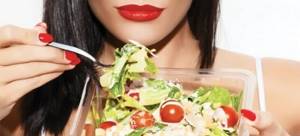
There are some rules that should not be ignored:
- Fruits and vegetables (light) can be eaten in unlimited quantities.
- Meat, fish, and many vegetables should not be fried, but baked (in a sleeve or on the grill), or boiled in a double boiler.
- Use only olive oil as fat for any dishes (instead of animal fats or butter).
- It is better not to heat treat anything that can be eaten raw.
- Soak all cereals for a day before cooking (in the summer they should be kept in the refrigerator).
- Pasta or cereals should be eaten for breakfast; eat bread only in the first half of the day. Eat vegetables and protein for dinner.
- You can allow yourself desserts, sweets, and dried fruits, however, only before lunch, so that the body has time to “burn” these calories before bedtime. But! To prepare desserts, it is better to use sugar substitutes (such as stevia) rather than sugar. Natural honey is also suitable.
- Drink a lot - from 1.5 liters per day.
- You are not prohibited from drinking alcohol (in small quantities). It is better to choose dry red wine. Important: you can give yourself such an indulgence only if you have not violated the rules of the diet.
- Tea and coffee are also allowed, but without sugar. As a last resort, drinks can be sweetened with honey, but in order not to “kill” the benefits of this valuable product, add it to an already cooled cup.
- It is also better to avoid salt. And so that meat and fish do not seem bland, season them with spices and herbs (say, oregano, basil, rosemary). Thanks to this, the body will not accumulate excess water, getting rid of existing “deposits”.
- No matter how light the foods of such a diet may be, do not overeat. It is better to eat often, but from small dishes.
What to fill the refrigerator with

For a week, one person will need the following amount of food:
- seafood (in the form of a cocktail or individually), fish such as trout, tuna, salmon - 4 servings;
- chicken, turkey - several servings (from 2 to 5);
- lean red meat (veal, beef, lamb, rabbit) - maximum 2 servings;
- 2-4 chicken eggs (but it’s better to buy quail eggs - they’re more convenient to use when preparing small portions, plus you don’t have to worry about eating too much, because such eggs are three times smaller than chicken eggs).
At the same time, consume daily:
- 3 servings of fruit;
- 2 servings of vegetables (fresh, steamed, baked);
- dairy products;
- red wine (your “upper limit” is 2 glasses).
And you will have to give them up...
- Semi-finished products and fast food. Fatty, with minimal benefits, often causing hunger ahead of time, they only “put a spoke in the wheels” of your successful weight loss.
- Sausage and frankfurters. You can steam fish as quickly as boiling a portion of sausages in boiling water, and the benefits from it are many times greater.
- Refined vegetable oil. Buy live, Extra Virgin. It is more expensive, but this is the case when it is better not to skimp on food - save on pills.
- Refined cereals. Steamed rice and flattened instant oatmeal make cooking easier, but they are of little benefit. “Refined foods” also include white rice, semolina, and wheat flour (to get all the benefits from wheat grains, it is better to buy them whole and germinate them). It’s better to choose brown rice, green buckwheat, plus don’t forget about unrefined millet and quinoa.
- Foods with hydrogenated fats, also known as trans fats. This category includes chips, a large amount of store-bought confectionery (especially with margarine), processed and glazed cheeses, and mayonnaise. You also need to be careful with ready-made breakfast cereals, crackers, and popcorn.
Reviews and results
Doctors' recommendations
An article published in the American British Medical Journal evaluates the Mediterranean diet as one of the nutritional systems that can increase life expectancy and maintain health. The authors of this work are American scientists.
Aesthetic medicine specialist A. Sternharz calls the diet a balanced one. He believes that with its help it is possible to successfully combat obesity and many chronic diseases. Adherence to the Mediterranean diet can increase life expectancy by 8 years (average data).
Nutritionist recommendations:
- Before starting the diet, you should undergo several fasting days, eating low-calorie foods.
- The menu should be based only on products from the list of permitted ones.
- You need to drink at least 1.5 liters of water per day.
- Fruits can be used as a snack, provided that they are not included in salads during main meals.
- You definitely need to exercise so that the weight starts to come off faster.
Reviews from those who have lost weight
Ekaterina: “The Mediterranean diet can hardly be called a diet. Rather, it is a diet that can be followed throughout life. A friend of mine followed this technique for quite a long time. She really lost weight, although the process is not quick.”
Veronica: “At the time when I lived in those parts, I ate accordingly. I really liked this diet: I managed to lose weight and improve my health. However, at home I returned to my usual menu.”
Natalya: “As for me, this is a pretty good diet, but financially very burdensome.”
Alevtina, 24 years old: “I followed a diet for ballerinas and a low-calorie diet, which was difficult for me, because I constantly wanted to eat. So I broke down, and the result turned out to be zero. Thanks to the Mediterranean diet, I managed to lose weight. In 8 weeks I lost 10 kg of excess weight.”
Marina, 31 years old: “The diet is very tempting, but it’s not cheap and is not suitable for everyone. It’s easier to stick to it in the summer, but I gain weight in the winter, so this diet doesn’t suit me.”
Mediterranean-Style Dietary Supplements: Yes or No?
The nutrition program from Leovit is designed for a week (or rather, 5 days). It’s called “Mediterranean Menu”.

Advantages of this product
- No need to cook. You get a cardboard case filled with “just add water” style bags for breakfast, lunch and dinner. Buying additional products (light) is possible, but not necessary. Just a dream for a busy woman or when traveling on vacation!
- The products taste good or are simply acceptable (although some are reminiscent of Doshirak).
- They do not cause sudden runs to the ladies' room, despite the fact that many products are claimed to cleanse the intestines.
- The tea/coffee included with the set may prevent you from drinking this drink with sugar in the future. And the body gets accustomed to smaller daily portions of food in this mode.
- In terms of cost, buying groceries and cooking will be much more expensive than this suitcase.
His weaknesses
Low effectiveness of such nutrition. Oddly enough, according to reviews, you can lose more kilograms by preparing all these Mediterranean dishes not with a kettle of boiling water, but completely standing at the stove.
The dishes are not very filling and do not completely satisfy your appetite.
Not all dishes are 100% natural - for example, you can see vegetable fat and flavoring in the ingredients.
This nutritional system is contraindicated for children (under 18 years of age), pregnant and lactating women, the elderly, those suffering from inflammation of the gastrointestinal tract, urolithiasis and cholelithiasis, diabetes mellitus, as well as chronic diseases in the acute phase. Moreover, this information is not indicated on the box itself, but is inserted inside in the form of an insert.
Conclusion
The Mediterranean diet is one of the nutritional methods that allows you not only to bring your weight back to normal, but also to improve your health. If you follow all the recommendations, you can cope with obesity and change your life for the better. Many people, having tried the diet once, remain faithful to it forever.
Author of the article:
Kuzmina Vera Valerievna |
Endocrinologist, nutritionist Education: Diploma of the Russian State Medical University named after. N.I. Pirogov, specialty “General Medicine” (2004). Residency at the Moscow State Medical and Dental University, diploma in Endocrinology (2006). Our authors
For the elderly
The Mediterranean diet helps older adults stay healthy longer. The diet is based on vegetables, whole grains, nuts and legumes, and fruits.
This type of nutrition and physical activity:
- reduces bone fragility;
- reduces weakness;
- stops weight loss associated with age-related changes;
- restores muscle strength.
Scientists have conducted research and found that the Mediterranean diet is very beneficial for older people. It maintains physical strength, weight, bone strength, helps maintain real energy for a longer time.

